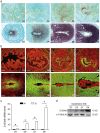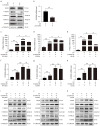Blastocyst-Derived Lactic Acid May Regulate S100A6 Expression and Function in Mouse Decidualization via Stimulation of Uterine Epithelial Arachidonic Acid Secretion
- PMID: 38334598
- PMCID: PMC10854550
- DOI: 10.3390/cells13030206
Blastocyst-Derived Lactic Acid May Regulate S100A6 Expression and Function in Mouse Decidualization via Stimulation of Uterine Epithelial Arachidonic Acid Secretion
Abstract
(1) Background: Inflammatory responses are implicated in embryo implantation, decidualization, pregnancy maintenance and labor. Both embryo implantation and decidualization are essential to successful pregnancy in rodents and primates. S100A6 is involved in inflammation, tumor development, apoptosis and calcium homeostasis. S100A6 is strongly expressed in mouse decidua, but the underlying mechanisms of how S100A6 regulates implantation and decidualization are poorly defined. (2) Methods: Mouse endometrial stromal and epithelial cells are isolated from day 4 pseudopregnant mouse uteri. Both immunofluorescence and Western blotting are used to analyze the expression and localization of proteins. The molecular mechanism is verified in vitro by Western blotting and the quantitative polymerase chain reaction. (3) Results: From days 4 to 8 of pregnancy, S100A6 is specifically expressed in mouse subluminal stromal cells. Blastocyst-derived lactic acid induces AA secretion by activating the luminal epithelial p-cPLA2. The epithelial AA induces stromal S100A6 expression through the COX2/PGI2/PPAR δ pathway. Progesterone regulates S100A6 expression through the progesterone receptor (PR). S100A6/RAGE signaling can regulate decidualization via EGFR/ERK1/2 in vitro. (4) Conclusions: S100A6, as an inflammatory mediator, is important for mouse implantation and decidualization.
Keywords: RAGE; S100A6; decidualization; implantation; inflammation.
Conflict of interest statement
The authors declare no conflicts of interest.
Figures









Similar articles
-
Endometrial glands are essential for blastocyst implantation and decidualization in the mouse uterus.Biol Reprod. 2013 Apr 11;88(4):93. doi: 10.1095/biolreprod.113.107631. Print 2013 Apr. Biol Reprod. 2013. PMID: 23407384
-
Studies using the estrogen receptor alpha knockout uterus demonstrate that implantation but not decidualization-associated signaling is estrogen dependent.Biol Reprod. 2002 Oct;67(4):1268-77. doi: 10.1095/biolreprod67.4.1268. Biol Reprod. 2002. PMID: 12297545
-
Evidence For Hmgn2 Involvement in Mouse Embryo Implantation and Decidualization.Cell Physiol Biochem. 2017;44(5):1681-1695. doi: 10.1159/000485775. Epub 2017 Dec 6. Cell Physiol Biochem. 2017. PMID: 29216626
-
Progress on the Role of Estrogen and Progesterone Signaling in Mouse Embryo Implantation and Decidualization.Reprod Sci. 2023 Jun;30(6):1746-1757. doi: 10.1007/s43032-023-01169-0. Epub 2023 Jan 24. Reprod Sci. 2023. PMID: 36694081 Review.
-
Uterine glands: biological roles in conceptus implantation, uterine receptivity and decidualization.Int J Dev Biol. 2014;58(2-4):107-16. doi: 10.1387/ijdb.130344ts. Int J Dev Biol. 2014. PMID: 25023676 Free PMC article. Review.
Cited by
-
Low pH induces amiloride-sensitive expression of leukemia inhibitory factor in endometrial cells.J Reprod Dev. 2025 Jun 6;71(3):115-123. doi: 10.1262/jrd.2024-105. Epub 2025 Mar 21. J Reprod Dev. 2025. PMID: 40128925 Free PMC article.
References
-
- Zhang T., Zhu W. Early transient suppression of immune checkpoint proteins T-cell immunoglobulin mucin-3 and programmed cell death-1 in peripheral blood lymphocytes after blastocyst transfer is associated with successful implantation. Fertil. Steril. 2020;114:426–435. doi: 10.1016/j.fertnstert.2019.12.022. - DOI - PubMed
Publication types
MeSH terms
Substances
Grants and funding
LinkOut - more resources
Full Text Sources
Research Materials
Miscellaneous

